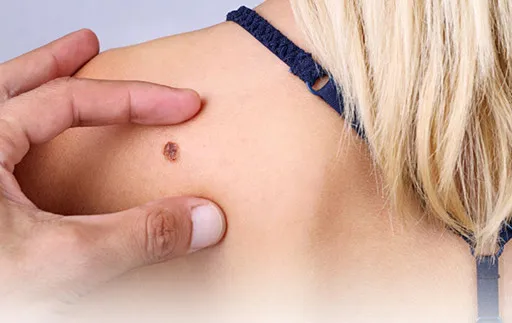
Reparative surgery
Skin Tumors Surgery Tunisia : skin cancer
Skin cancer is one of the most common forms of cancer. Skin tumors can vary widely in appearance and are best detected and treated early on. Most skin cancers start with small skin changes, bumps, discoloration, or sores that get bigger over time or have a history of back and forth. Any unusual areas of your skin should first be assessed by your doctor and referred to a plastic surgeon if complex surgical treatment is needed.

In skin cancer, the skin cells of the body are affected and are mainly caused by ultraviolet rays from the sun.
A specialized plastic surgeon is recommended to treat skin cancers when the treatments are complex or when they occur in aesthetically sensitive areas such as the face.
What are the different types of skin cancer?
There are three main types of skin cancer:
Basal cell carcinoma
Basal cell carcinoma is extremely common and is the most common type of skin cancer. It mainly occurs in areas of long-term sun exposure, particularly on the face, head, neck, and trunk, but can occur anywhere on the body. Basal cell carcinomas tend to grow slowly, over months or years, and rarely spread. They can usually be cured with surgery, leaving excellent cosmetic results. They most often present as a firm red or greyish-red lump, which may bleed occasionally.
Squamous carcinoma
Squamous cell carcinoma is the second most common form of skin cancer, and usually grows faster than Basal cell carcinoma and is more often seen in older people. They are more serious and have the potential to spread elsewhere in the body. Squamous carcinomas usually present as a rapidly growing, scaly pink mass, which can also break down, bleed and ulcerate. They mainly occur in areas exposed to the sun, such as the face and backs of the hands.
Malignant melanoma
Although it is the least common skin cancer, it is the most dangerous. melanoma occurs mainly on skin exposed to the sun, but can occur on generally covered skin and rarely in areas that have never been exposed to the sun. Melanoma can develop from an existing mole or appear as a new brown, red, or black spot that changes and gets bigger. Fortunately, if diagnosed early, most melanomas can be cured with simple surgical treatment.
Have I been told I have precancerous skin growths? What is it?
There are also a number of precancerous skin tumors, such as solar keratosis, which require treatment before they develop into skin cancer.
Solar keratoses, also known as actinic keratoses or “sun spots”, occur as a result of excessive exposure to the sun, causing red patches to develop. This skin problem usually occurs on the face, neck, hands, forearms, and ears. To prevent solar keratosis from getting worse, it is recommended that you stay out of the sun as much as possible, always wear sunscreen when you go out, and try to wear clothes that can protect your skin from the rays. harmful from the sun.
What are the risks of developing skin cancer?
There is an increased risk of developing skin cancer in those who:
- Were exposed to the sun for a long time with tanning and sunburn in their youth, or continued regular exposure to the sun due to work or leisure activities.
- Severe sunburn episodes
- Have a fair complexion, freckles and / or do not tan
- Have a personal or family history of skin cancer.
- Are immunocompromised.
It is important to note that anyone can develop skin cancer.
How can I detect skin cancer?
If you think you have symptoms of skin cancer, it is important to see a doctor immediately to avoid any future health risks. Some of the symptoms to watch out for are:
- Persistent red, pale or pearly areas / bumps on the skin.
- Change in size, shape or color of moles.
- A spot that bleeds periodically and then heals.
- New moles or freckles that change in appearance over time or bleed.
- Dry, scaly, non-healing wounds.
If you experience any of these symptoms, your doctor may take a biopsy on the area to determine the problem.
How to treat skin tumors?
Skin cancers can be treated with a number of methods depending on the type of tumor, its stage of growth and where it is on your body. Methods include creams for skin cancer, for early or shallow lesions, 'scraping' techniques, or complete surgical removal that may require reconstructive surgery.
The most important skin cancers are best removed surgically. Some of the surgical options may involve moving the skin around the cancer after it has been removed (a skin “flap”) or using skin from other areas of the body to cover the treated area (skin “graft”). Even complex skin cancers such as those that appear on the face can be successfully removed with very subtle scars, leaving the best possible aesthetic result.
The surgery, what to expect?
If the tumor is small, simple excision (surgical removal, with stitches) is usually sufficient, and can often be performed quickly and easily under local anesthesia, at the El Yosr International Clinic Day Hospital in Sousse in Tunisia. This usually leaves a thin, barely visible scar that fades over time. The specimen will be sent for verification by a pathologist to ensure that it has been completely removed. The risks of surgery are low.
What happens after the skin cancer is eliminated?
In simple cases, removing skin cancer is relatively straightforward, and in most cases, you can resume your normal activities the same day. It may be recommended to avoid strenuous exercise for the first few days. Instructions on how to minimize scarring should be followed. You will also be informed of the results of your pathology.
Please do not hesitate to contact us with any additional questions you may have about skin tumor surgery. Our team will be happy to answer all your concerns.


